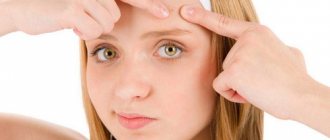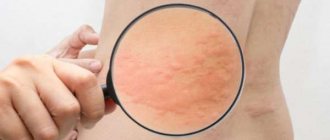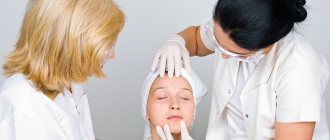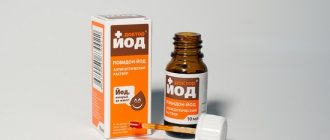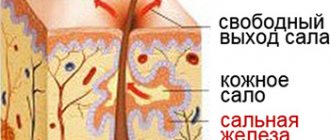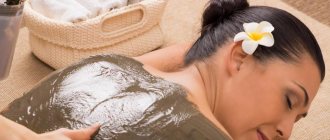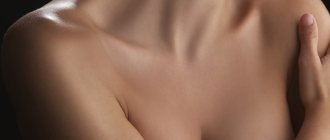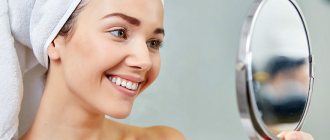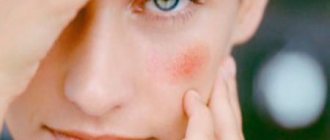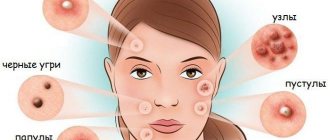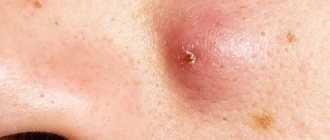Exogenous factors
The evolution of the morphological elements of acne is as follows: closed comedones and milia, open comedones, follicular papules and nodes, follicular pustules, scars and spots (vascular, hyper- and hypopigmented).
Comedones
Closed comedones are small superficial internal skin cysts - whitish or slightly yellowish vesicles filled with sebum and epidermal cells), no more than 1 mm in size, rising above the skin or located in the thickness of the skin, determined by palpation in the form of small compactions.
Open comedones look like dots with a diameter of 0.1 to 1 mm, sometimes they rise above the skin. Their color can be light yellow, brown and even black.
Papules
A follicular papule is a small cone-shaped pink or bright red nodule with a diameter of 1-3 mm. Usually rises above the skin, has an inflammatory infiltrate around it.
Pustules
Pustules - papules turn into them over time, there are transitional stages - “papulo-pustules”. Pustules can be superficial, when blisters - yellowish pustules are located close to the surface of the skin, or deep.
Over time, the pustules burst, releasing pus, and heal with the formation of temporary thickenings of the epidermis. Scars do not form in their place, but bluish spots may remain, more often due to injury or squeezing out acne.
Small pustules dry out without separation of pus when drying agents are used.
Nodes are deep inflammatory elements, reach the size of a pea or larger, are painful, dense, adherent to the surface of the skin, take a long time to resolve, can exist for weeks, and after involution they heal with the formation of scars.
How to get rid of acne as a teenager: skin care and medications
The first rule of acne prevention is to keep your skin clean at all times. Pimples appear due to hormonal surge
. But they become inflamed and do not heal for a long time when hygiene rules are violated.
Typical mistakes of teenagers:
1) Rare or too frequent washing. You need to wash your face morning and evening with warm water and mild soap. The best option is to buy salicylic or glycerin soap at the pharmacy.
2) Sleep with makeup on your face. Decorative cosmetics must be removed in the evening.
3) Do not cleanse your skin after vigorous activity. Walking, sports, disco – in these situations the skin sweats and attracts dust
. Upon returning home, you should thoroughly wash your face, neck, and shoulders.
4) Squeeze out pimples with your nails. The most dangerous area is the middle of the face, from the bridge of the nose to the chin.
. People call it the “triangle of death”, since an infection introduced here can spread to the brain, bones, and eyes. Instead of squeezing, you should lubricate mature pimples with a cotton swab containing an alcohol tincture of calendula.
5) Use alcohol lotions to wipe your face. This mistake is typical for young men. Alcohol, of course, dries out the skin.
.
But the more the skin dries, the more sebum is released
. It is better to use a lotion without alcohol (for example, salicylic) or a herbal decoction.
6) Use oil-based cosmetics. “Adult” powders and blushes clog pores that are already full of oil. Cosmetics should be water-based or dry and applied in a thin layer.
7) “Mask” acne with foundation. Even young men use similar tricks. Makeup makes acne more inflamed.
Care for acne-prone skin includes masks and steam cleansing. Masks are made from kefir or yogurt
.
You need to moisten a gauze napkin in kefir and put it on your face for 15 minutes
. or just wash your face with yogurt at night. Such procedures are carried out daily.
Facial cleansing is done by a cosmetologist in a specialized office. The procedure can be carried out at home - subject to hygiene rules . To do this, brew 2 liters of boiling water 2 tbsp.
.
spoons of medicinal plants (chamomile, sage, mint), leave to brew for half an hour
.
Then the infusion is boiled to create more steam and poured into a basin
.
Cover the head with a bath towel and “hover” the face over the basin for 15 minutes. Use a sterile napkin from a pharmacy package to wipe your face
.
Most black comedones go away on their own from the healing steam. You should not squeeze pimples on steamed skin
. You need to wash your face with a hot chamomile decoction and let your face dry naturally.
In severe cases, when acne takes on the character of a continuous rash, deep painful cysts often appear, you should consult a dermatologist . After conducting a diagnosis, the doctor will determine how a teenager can get rid of acne
. The most common medical treatments:
• creams and gels with tretionol, benzoyl peroxide;
• taking antibiotics orally (erythromycin, clindamycin, doxycycline, metronidazole, amoxicillin, cephalexin);
If there is no effect from conventional treatment, large deep cysts that leave scars, isotretinoin therapy is prescribed. No medications should be taken without a doctor's prescription and supervision.
Causes
Teenage acne on the skin, in addition to hormonal changes, can be triggered by the following factors:
- Unstable emotional and psychological background characteristic of a developing organism.
- The pathological inflammatory process begins with the formation of a sebaceous plug in the gland duct. So much sebaceous secretion is produced that it constantly accumulates in the excretory cavity, thickens and forms subcutaneous infiltrates.
The following factors usually influence the appearance of acne in teenagers:
- genetic;
- seasonal and climatic;
- hormonal changes during puberty;
- diseases of the liver and gastrointestinal tract;
- poor nutrition;
- stress;
- disruption of the functioning of the endocrine glands;
- improper skin care or lack thereof: for example, abuse of powder, foundation;
- prolonged exposure to the sun.
Excessive sebum production leads to clogged pores. Also, the pores can become clogged with horny scales of the follicular duct, then a microcomedone is formed - closed or open (“black dots”).
Blockage of the sebaceous gland duct prevents air access, which causes bacteria to multiply.
Acne often develops during periods of hormonal surges in the body. There are also other common reasons, such as:
Hormonal disbalance . At the time of puberty, the level of sex hormones in the body rises. This leads to a malfunction in the nervous system and increases the activity of the sebaceous glands, as a result of which, due to an excess of fatty secretion, the pores become clogged and rashes appear.
Avitaminosis. Deficiency of vitamin A and B vitamins also suggests skin problems. Their lack indicates an incorrect diet. It is these vitamins that affect the stability of the glands and the renewal of processes in skin cells.
Oily skin . The oiliness of the epidermis can be influenced by genetic factors and hormonal imbalances, which increase the production of sebaceous secretions.
Demodicosis . Demodex is an intradermal mite that lives on almost any person. However, a favorable environment for its activation is excessively oily skin and increased levels of hormones.
Acne severity in teenagers
- Mild - comedonal acne - up to 20 comedones, up to 10 pustules. There are no nodes, cysts, fistulas, inflammations, scars.
- Moderate - papulopustular acne - more than 20 comedones, 10-20 pustules, up to 10 nodes, there are clear signs of inflammation. There are no cysts, fistulas, scars.
- Severe - papulopustular acne - more than 20 comedones, more than 20 pustules, 10-20 nodules, many cysts and fistulas, severe inflammation, scars are present.
- Very severe - conglobate acne - multiple comedones and pustules, more than 20 nodes, many cysts and fistulas, very severe inflammation, many scars.
Diet
When dealing with acne in a teenager, nutrition plays a huge role.
In the absence of a diet and a balanced diet, no procedures or remedies will help get rid of acne .
It is recommended to eat more fresh vegetables, fruits, and greens, which contain a lot of fiber. Daily consumption of porridges made from millet, buckwheat, oatmeal and other cereals will improve the condition of the skin. You should not get carried away with bread, or eat coarsely ground rye bread.
Fermented milk products have a beneficial effect on the digestive system. You should also eat lean meats.
What can you drink? Green tea, still mineral water, freshly squeezed juices. Clean drinking water will cleanse the body of toxins and saturate the skin cells with moisture.
It is also necessary to consume foods rich in vitamin A (fish oil, carrots, black currants, corn and others), E (olive, flaxseed oils), B vitamins (cheese, eggs, liver, kidneys, legumes, spinach), zinc (seafood , liver, lean beef stew, asparagus).
Fish must be included in the diet. Or eat fish oil and flax seeds . Flax seeds can be added to kefir and porridge.
It is necessary to exclude from the diet:
- smoked meats,
- seasonings,
- fatty fish and meat,
- carbonated drinks,
- strong coffee, tea,
- sweets,
- flour, fried, salty foods,
- fast food.
Egg consumption should be reduced to two per week.
It is also necessary to include garlic, ginger, lemon, and parsley in your diet.
Acne symptoms
Juvenile acne can be open or closed.
Closed comedones are white nodules that are not visible on the skin surface. Due to the fact that dust accumulates in the pores over time, black spots appear on the epithelium of the skin and come to the surface. They are usually found in the forehead and chin area.
If an existing acne continues to inflame, and treatment does not arrive and it cannot be gotten rid of in time, a pimple will appear, which is characterized as a red-blue dense lump under the skin that looks like a pea.
Large bubbles like these can leave scars. They need to be treated.
Some more tips
The skin requires daily cleansing with cosmetics selected to eliminate acne.
The cleansing gel should not contain alcohol.
Girls should stop using foundation and powder, and always wash off makeup before going to bed.
If there are no contraindications, treatment for acne should be supplemented with exercise . Running, brisk walking, and an exercise bike are suitable for this. When playing sports, blood circulation improves. Tissues and organs receive more oxygen.
You also need to remember that you should not squeeze pimples. You can bring in dirt, “spread” acne all over your face and leave scars and scars in place of the squeezed pimples.
Now there are a lot of methods and means that can help a teenager recover from acne. Many of them are effective, but some can cause serious harm to the skin.
If acne appears on your face, you should not listen to the advice of friends . Only a dermatologist will select the course of treatment that is right for you.
Acne treatment
Common pubertal acne does not require serious treatment. However, not only a dermatologist treats it; he can advise the teenager to seek help from a nutritionist.
A nutritionist will analyze the teenager’s diet, and then remove from it all products that provoke comedogenicity, for example, sweets, carbonated drinks, chocolate, strong hot drinks such as coffee and tea, river fish, seaweed and foods with a high iodine content.
When treating mild to moderate acne, it is best to combine topical products and careful daily facial skin care. There are two modern, effective and safe drugs for external use: Baziron and Skinoren.
“Baziron” is necessary to suppress bacterial colonies, exfoliate dead skin cells, and oxidize sebaceous secretions.
It also prevents the formation of blackheads. Apply to a cleansed face pointwise, twice a day, the result appears after several months of regular use.
Side effects include overdrying of the skin, leading to flaking.
"Skinoren" is based on azelaic acid, which has a complex mechanism of action.
The product inhibits bacterial growth, disinfects the skin, and treats inflammation. In addition, Skinoren helps lighten post-acne scars.
In the first few days, it may cause discomfort in the application area, manifested in tingling, irritation and local redness.
Improvements will become noticeable after 6 months of regular use. Used spot-on, once a day. There are practically no side effects unless the dosage is exceeded.
To begin with, the skin should be cleaned and dried, then apply the ointment to the acne lesions, avoiding its contact with healthy skin.
Regular use is also important, since it is impossible to get rid of acne in one day. After the onset of stable remission, Skinoren and Baziron can sometimes be used for preventive purposes.
The technique appeared relatively recently, but has managed to prove itself positively. Clogged sebaceous ducts open painlessly, excess sebum is removed, and a layer of keratinized and dead cells is removed.
Folk remedies
Folk remedies also help against acne in teenagers.
Infusions and decoctions of birch, nettle, and dandelion leaves are effective against acne. You can wipe your face with the juice of calendula, aloe, and eucalyptus, which are known for their anti-inflammatory and antibacterial effects.
Aloe contains B vitamins, vitamin C, E, and beta-keratin. The plant juice is known for its anti-inflammatory, regenerating, bactericidal properties . Aloe that is more than three years old is suitable for use against acne.
The leaves of the plant should be kept in a dark place for about 10 days .
Then squeeze the juice into a glass container and close tightly. Store the tincture in the refrigerator.
You can also mix the tincture with alcohol in a ratio of 1/5. For internal use, it is better to consult a doctor . Can be taken externally.
An aloe mask is also useful for problem skin. Beat the egg white in a blender, add chopped aloe leaves, stir, add a drop of lemon juice. Apply to face and leave for about half an hour.
Rinse off with warm water. Protein will shrink pores . Lemon contains vitamins that are beneficial for acne-prone skin; it tones and heals. The skin will tighten, take on a healthy appearance, and get rid of inflammation. Masks are used twice a week. You need to strengthen the properties of the aloe mask with acne cream.
Rubbing the skin with ice cubes from a decoction of medicinal herbs helps against acne For example, daisies. Masks made from bran, yeast, carrots, and cosmetic clay will help improve the appearance of your skin and get rid of blemishes. Pustules and acne will go away very quickly.
How to treat acne in teenagers
Often, various therapeutic methods, as well as cosmetics, lead to remission, or, less often, to a solution to the problem. When choosing therapy, you should rely not only on the severity of acne, but also take into account the general condition of the teenager.
Main objectives of treatment:
- prevent the formation of comedones;
- remove comedones;
- reduce sebum production;
- prevent the opening of comedones and the development of inflammation;
- use combination therapy;
- prevent the appearance of scars.
Remedies used externally in the treatment of acne in adolescents are used when there are no signs of inflammation.
Their action is aimed at reducing the formation of new acne. Typically, dermatologists prescribe drugs to treat acne such as:
Special gels, lotions, and creams are good for treating acne on the back and other parts of the body. They contain agents that can soften hard plugs and open pores.
These can be antibiotics, comedolytics, sulfur, resorcinol. Adolescents can use such drugs from several months to 1 year.
Acne medications containing erythromycin, clindamycin, tetracycline, doxycycline and sulfamethoxazole are taken for 2 to 4 months.
Taking them may be accompanied by indigestion, dizziness, allergic reactions, genital candidal infections and even discoloration of teeth.
Treatment of acne in adolescents with its moderate form consists of minimizing inflammatory changes and preventing the formation of new acne.
They need to be used for 2 – 4 months.
Severe forms of acne require the use of isotretinoin orally, which reduces the secretion of sebum. In combination with antibiotics, this drug is taken for 4–5 months.
Juvenile acne usually does not require global treatment. It may be limited to the use of special cleansers that can degrease the skin and normalize sebum secretion.
After analyzing the diet of a growing child, it is necessary to eliminate chocolate, strong tea, coffee, fish, seaweed and all iodine-containing products from it.
What food should be constantly present in the diet of a young person suffering from acne? It is like this:
- foods high in zinc (crabs, shrimp, soybeans);
- foods rich in fiber;
- any fermented milk products;
- fruits and vegetables.
When teenagers or their parents turn to doctors for help, the rash usually has a moderate or severe form, which cannot be cured without a thoughtful, comprehensive approach.
To begin with (especially girls), you need to contact a cosmetologist who will draw up the simplest plan for a teenager, aimed at preventing new rashes and eliminating old ones.
Approximately the therapy will look like this:
- Special diets reduce sebum production.
- Acne inflammation is treated using cosmetic procedures that can suppress pathogenic organisms inside the follicle - microcurrent therapy, neodymium laser treatment.
- Comedones and pustules are removed using mechanical, vacuum, ultrasound or chemical methods.
- They cleanse pores and remove dead cells with one of the types of peeling. This reduces possible scarring.
- Stimulate regenerative processes using mesotherapy and cryotherapy.
A regular remedy is prescribed for home antiseptic treatment and removal of excess fat.
Dalatsin T, Zenerit, Clindamycin, Skinoren have complex effects of this kind.
The most affordable option is to use salicylic acid, which includes both cheap salicylic alcohol and the widely advertised CLEAN & CLEAR ADVANTAGE.
If the rash is complicated by atheromas or boils, you cannot do without a dermatologist. The doctor will conduct an examination and send the teenager for additional consultations with an endocrinologist, gastroenterologist, or gynecologist so that they can help detect and eliminate the root cause of the disease.
For his part, the dermatologist is obliged to prescribe and monitor the use of drugs that are potentially dangerous and not used in cosmetology:
Reviews and opinions about the effectiveness of therapy
If you examine patient reviews of medications for acne on the face, it turns out that this is a rather sensitive topic. Some participants are eager to find out a universal remedy for acne that will help regardless of the cause of the problem.
At the same time, on forums you often meet people who have already completed a course of therapy and therefore have experience in treating acne. They are against the thoughtless use of medications, and especially antibiotics, although they do not deny their effectiveness.
Roaccutane turned out to be one of the most effective remedies, but along with the therapeutic effect, the drug gives many side effects:
- dry mouth;
- chapped lips;
- thinning hair;
- kidney and joint problems;
- nosebleeds;
- headache;
- depression and much more.
What not to do?
The fight against acne will not be effective if you do not pay attention to a number of prohibitions. What can’t be done so as not to worsen the situation and help medications quickly cope with the problem?
The recommendations of dermatologists are as follows:
- Do not wash your face with hot water, which provokes the sebaceous glands;
- squeeze out pimples yourself, which can lead to infection of large areas of skin and scarring;
- It is prohibited to drink alcoholic beverages and smoke;
- use any means without a doctor’s prescription;
- delay treatment.
